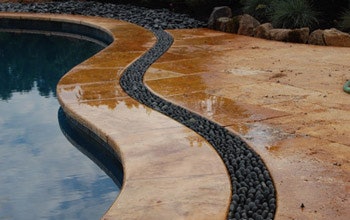
When working on a pool, every surface is an opportunity to execute your prowess as a designer. One such surface: coping. This fundamental component sits on top of the beam around the edge of the pool, and is arguably the most noticeable part of a pool’s construction. Let’s delve into just some of the design possibilities and current trends coping has to offer.
Through the years, trends in coping have come and gone, but three materials remain steadfast as the leaders in popularity: pre-cast concrete coping, stone, and brick.
Stone is by far the most popular; it comes in a slew of different options that range from affordable to expensive. Oklahoma flagstone, a denser flagstone, is one of the more common stones used in Southern regions and is quite versatile in application. In addition, it’s available in a spectrum of shades: Tennessee, in shades of grey and slate; Arizona buff, which is generally lighter than Oklahoma; Arizona pink (the name speaks for itself) and Granbury limestone, which comes in white and yellow tones). With a broad selection of tones to complement any design and a reasonable price tag, flagstone is a great material to discuss with your clients.
Another popular, yet more expensive stone option is travertine. Travertine is a limestone generally put through a tumbling process and requires a coat of sealant as it is quite soft and takes stains easily. That said, travertine is easily my favorite material to work with. Color choices range from ivory to chocolate, and texture ranges from tumbled to honed. And it’s versatile: While it’s generally installed in a square-cut pattern, you can cut it to almost any shape needed. At my company, the majority of our high-end projects use travertine for the coping and often as a cap for walls and kitchen counters as well. I have an ivory travertine coping on my own outdoor kitchen in my backyard. (Leftover from a job, of course!)
Precast concrete coping is exactly what it sounds like: it’s concrete (often infused with dye to give it a particular color) poured into a mold. This is a fairly basic material (sometimes simple is good) and can be used in most any application, from freeform to geometric pools. They can come in pieces as small as 6 inches up to 24 inches, and even larger pieces can be custom-ordered. There are a world of possibilities for concrete coping; I’ve seen people use single colors or try multicolor pieces in regular and irregular sequences. (But I typically caution against using too many different shades to avoid making the pool look busy.)
Finally, brick coping is actually quite similar to the brick you would use on a house: it’s essentially fired clay, and is very cost effective. While brick has its place in the market, I generally push my clients away from it as it does not age well and has very little visual interest.
Traditionally, my clients have used a gray mortar joint for their coping and vertical veneer in the pool, but guess what: you can add color. One of my favorite looks is a dark mortar trim joint with a darker material, like a deeper shade of Oklahoma. Another popular option with the Oklahoma flagstone is a buff mortar joint (or sand color) that really blends the mortar joint into the stone, giving it a very natural look. Adding color to your mortar joints is not very expensive and can really add some flair to the pool coping and vertical veneer.
This post originally appeared on The Complete Backyard. It was reposted with permission.











































